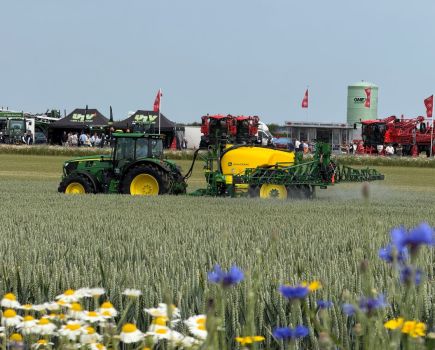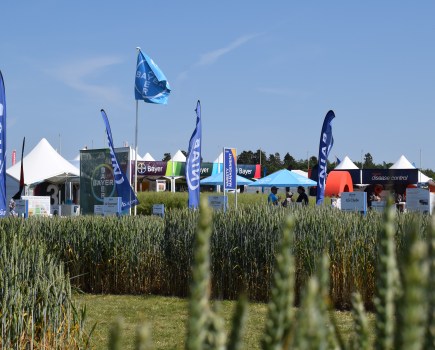Practical experience has outstripped research results within the regenerative farming world, but that’s slowly changing. To find out more, CPM joined delegates at the Green Farm Collective Conference.
“There’ll always be trade-offs when we use different farming systems; it’s important we show the true picture for different ecosystem services.” DR RUTH WADE
By Mike Abram
Detailed research trials to provide evidence about the impact of using regenerative farming practices have been relatively few and far between. But, as speakers at the recent Green Farm Collective conference underlined, that’s beginning to change.
Trials such as one conducted by the University of Leeds at its 317ha commercial mixed farm, are starting to provide some research-led evidence of both the benefits and challenges from using regenerative farming principles.
The aim of the trial is to demonstrate and measure the impacts of different strategies commonly used within regenerative farming systems, explained Dr Ruth Wade, a lecturer in sustainable agriculture and lead for the project at the university.
REPLICATED TRIAL
Seven different farming systems are being compared in replicated plots, including a control using conventional management. Another four systems follow different combinations of the five typically used principles of regenerative agriculture (minimise soil disturbance; maximise crop diversity; keep the soil covered; maintain a living root; integrate livestock), while the final two comparisons have been in a herbal ley for the initial three years of the trial. One of these is due to be integrated back into an arable rotation next season, while the other will remain as a herbal ley long term.
“The first challenge was deciding what’s conventional management as there are many ways you could do that. We narrowed it down to not following any of the five principles of regen ag,” said Ruth.
“For example, when we minimise soil disturbance in our other plots, we plough and power harrow in our conventional plot, and when we keep soil covered in some plots, we leave it bare over winter.”
The simplest of the regen ag plots follows just two of the principles – minimising soil disturbance and keeping the soil covered – after feedback from farmers and advisers suggested growers ‘dipping their toe’ into farming regeneratively would start with these.
Each further treatment then adds another principle, starting with increasing diversity, followed by integrating livestock and then finally keeping a living root in the plot all year round using a clover understory.
Using large 12m by 40m plots means commercial equipment and integrating livestock can be done practically on the site, which has high magnesium, clay loam soils with a pH of 7.7.
She explained a detailed soil survey before the trial started in 2022 gave baseline data to compare against, while each year a large suite of measurements is taken such as water quality from each plot, soil dwelling invertebrate populations, weed, pest and disease incidence, greenhouse gas emissions and carbon stocks, as well as yields, costs and gross margins.
“We’re very committed to not being focused on one thing,” added Ruth. “There’s always going to be trade-offs when we change practices or use different farming systems, so it’s important we show the true picture of these for different ecosystem services.”
After a successful winter wheat crop in year one of the trial in 2022/23 that yielded 11.5t/ha with very little difference in systems, last year’s spring barley crop was a completely different story, she pointed out.
“It never stopped raining – we tried to drill our spring barley on a dry day but it was still too wet and it only established in the conventional plot. In the direct drilled regen plots, we had a very tight layer on the soil surface which the barley seedlings couldn’t push through.”
Those plots were successfully redrilled following a small amount of soil disturbance, she said, although yields were reduced especially in the plot with livestock integration.
There were also impacts for both the clover understory, which had to be knocked back with glyphosate for the crop to be redrilled, and the establishment of a following overwinter cover crop after a late spring barley harvest.
“The weather is tricky with these systems,” noted Ruth. “But the clover understory for the second year in a row came into its own compared with drilling a cover crop, because it was already there and covered the plot much earlier.”
The downside of the clover system has been that in the current season’s dry spring, the clover was competing for what moisture was in the soil, she added. “This has led to serious drought conditions for the beans in these plots and they reached wilting point just before rain arrived.”
Preliminary results from the various measurements has shown a loss in carbon stocks from the ploughed plots in the top 10cm, outlined Ruth. “But when we started looking deeper in the soil we found we’d taken soil organic carbon from the top layer and essentially buried it further down the profile. It’ll be interesting to track this.”
In contrast, there’s a trend that soil organic carbon is increasing in the top 10cm of soil in the regen plots, mainly because of adding farmyard manure, she added, with little difference lower down the soil profile.
Measurement of greenhouse gas emissions has found higher levels of nitrous oxide emissions in the regen ag plots than in the conventional system, possibly due to a greater level of microbial activity and / or the integration of legumes.
“This is something we have to understand better, but maybe suggests we can or should apply less fertiliser in regen systems,” she concluded.
University of Reading lecturer, Dr Millie Hood, has also been working with farmers to research the impact of cover cropping on farm. For the project, Millie worked closely with farmers to co-design trials to assess practical changes.
“Co-design comes up with more creative solutions that are usable, while also creating a sense of community between people with shared goals, including farmers and researchers,” she said.
After a series of workshops and meetings with 16 farmers recruited with the help of LEAF, the Showcase project investigates the frost-tolerance of different cover crop species – whether this affects biodiversity ecosystem services, and if it could be used to reduce the amount of glyphosate required to terminate cover crops.
“The theory is that in winter, sensitive species will gradually die off to provide organic matter for decomposers through winter rather than a massive flush at the end. This could improve infiltration as the roots decompose through winter and you may require less glyphosate to remove covers and put less strain on machinery planting the following crop,” she explained.
In the trials, the over-wintered cover crop mixes of four frost-sensitive species, four winter hardy species (see table), and a mix of all eight were planted in a tramline experiment following a winter wheat crop. A control strip where no cover crop was planted was also compared.
| Frost sensitive cover crop mix | Winter hardy cover crop mix |
| Early English vetch | Winter vetch |
| Berseem clover | Crimson clover |
| Black oats | Protector rye |
| Buckwheat | Linseed |
Despite a dry autumn in 2022 that hindered early establishment, and sharp early frosts that took out species earlier than expected, some interesting results were found, suggested Millie.
In particular, earthworm numbers increased by 53% during cover cropping and by 66% in the subsequent spring barley crop, while similar increases in spider abundance (26%) were seen in the cover crops.
Firm conclusions about differences between mixes has been harder to make, however. “The frost-sensitive mixes provided by Oakbank did what they were supposed to do and gradually decayed during winter. This reduced plant cover before planting, which could mean lower use of glyphosate, but we found intermediate benefits to spiders and decomposition – more cover meant more spiders and greater decomposition.
“But we didn’t find significant differences between four and eight species in this experiment, which is important for cost,” she concluded.
This article was taken from the latest issue of CPM. Read the article in full here.
For more articles like this, subscribe here.
Sign up for Crop Production Magazine’s FREE e-newsletter here.




